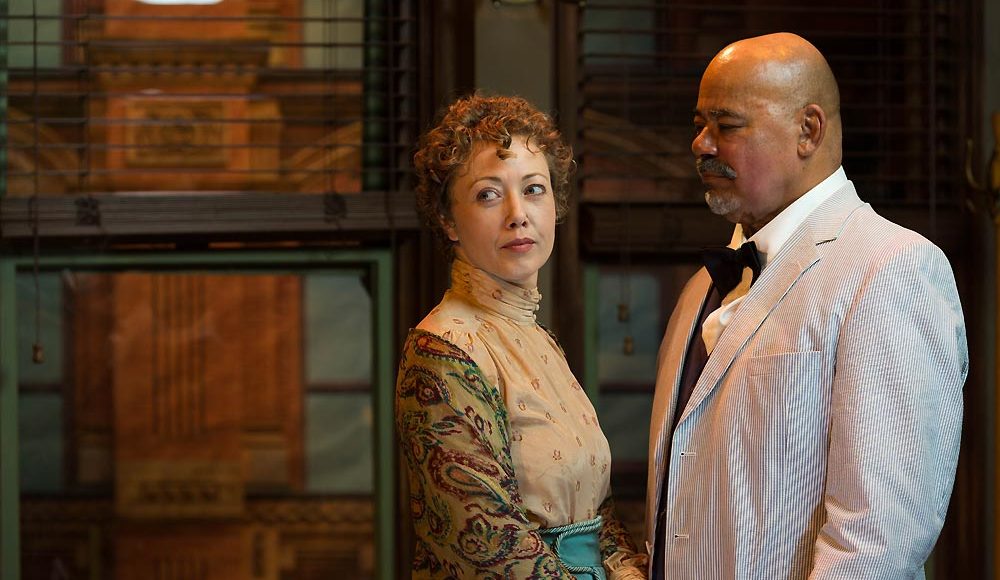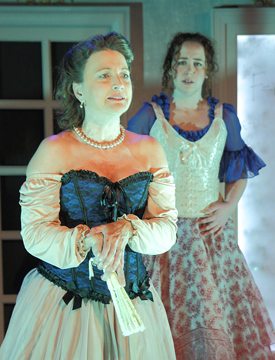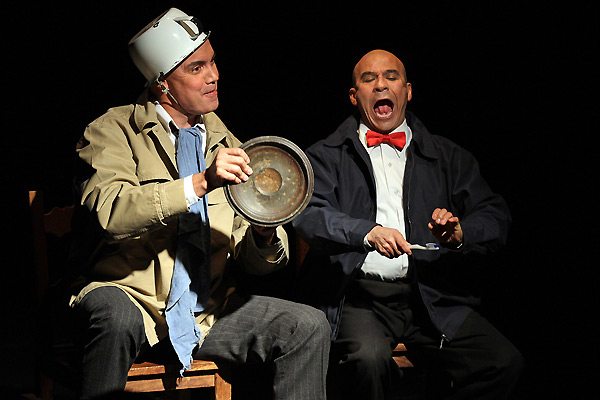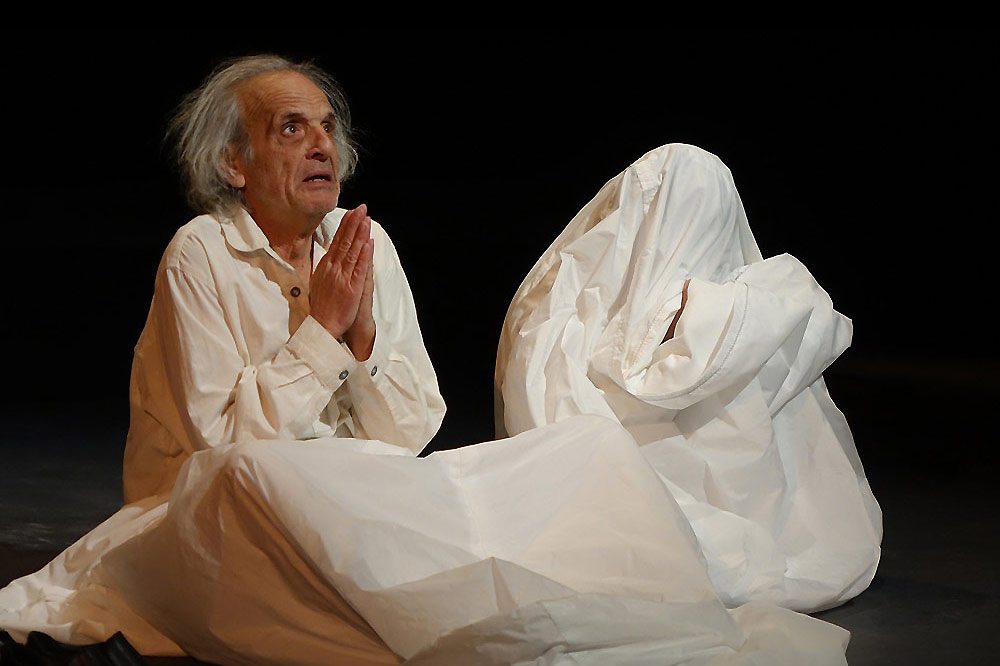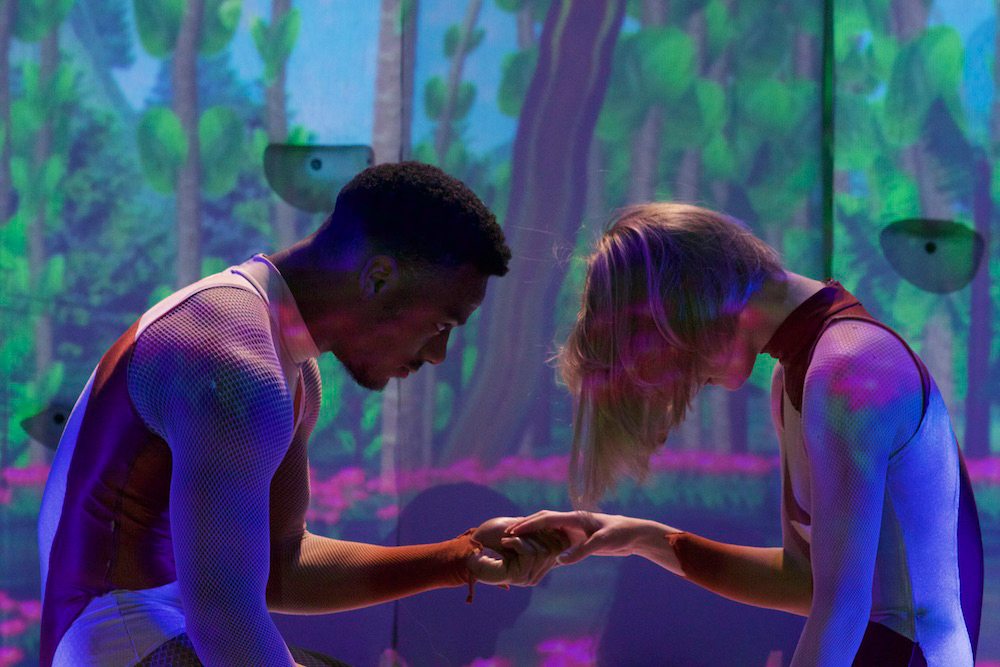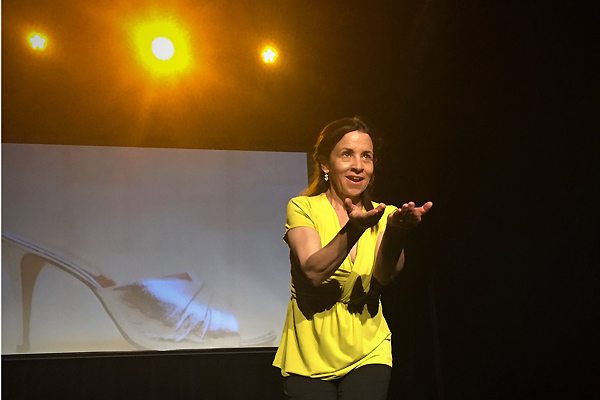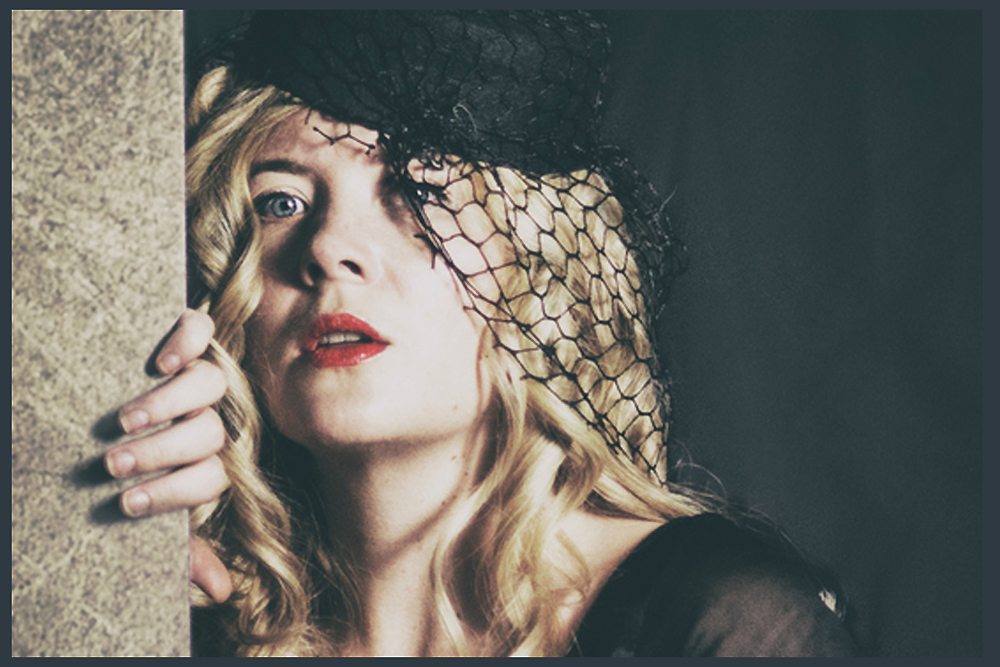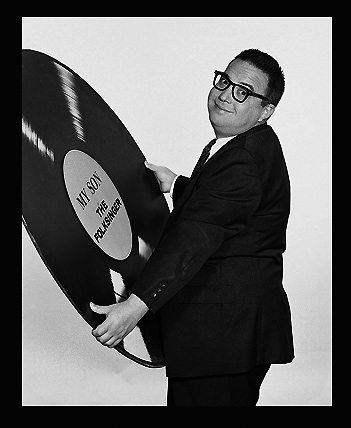There are identifiable years in the history of this nation that are shrouded in a foreboding of dire times ahead; 1860, 1877, 1914, 1918, 1929, 1941, 1963, 1979 and 2001.
Like others, around 65,844,954 others, I foresee 2017 will be firmly fixed in that grim roster.
But let us set aside here, in this worst of years, a moment in which to praise the best of theatre.
Now you will note, with few exceptions, this roll will reflect a deficiency as far as those productions which played in our city’s larger venues.
The reason for this is that I’m not overly interested in the work done at the Pantages, The Music Center and the like. Those New York shows that come schlepping at us over the amber waves of grain, as well as those that travel the route in reverse to “the Great White Way,” I, generally, find slickly mounted, stylishly staged and vacuous.
I did find myself at a few, but the only one I wish to mention is Rajiv Joseph’s Archduke at the Mark Taper Forum; an interesting though not fully-leaven meditation on the events that hurled the world into that abattoir known as World War I.
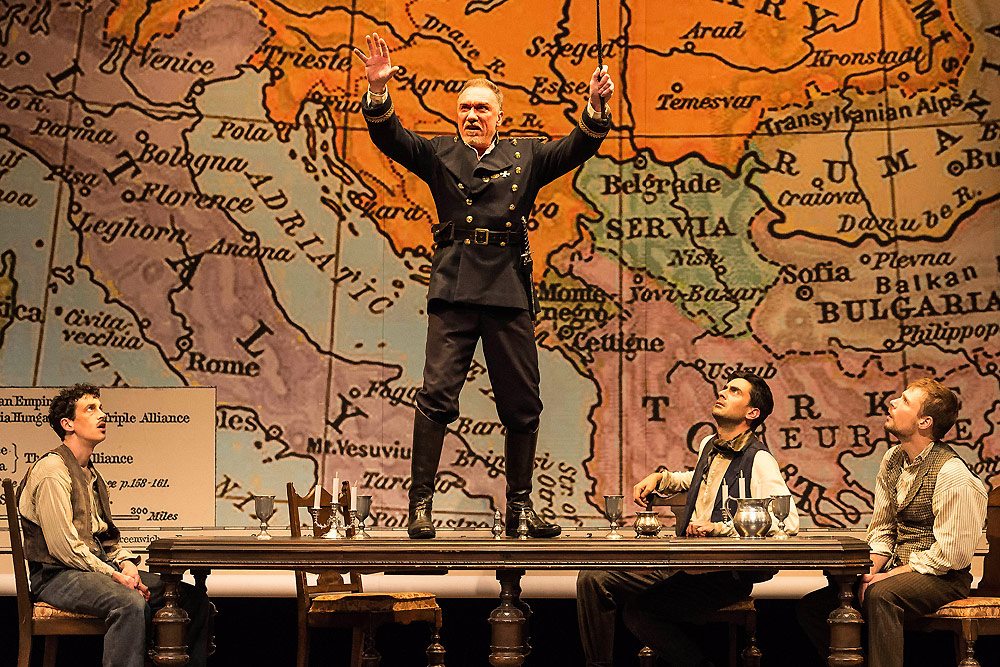
Stephen Stocking, Patrick Page, Ramiz Monsef, Josiah Bania (Photo by Craig Schwartz – Courtesy of Center Theatre Group)
The only elements that stood out, I thought, were in two of the performances, and here was a momentary melding of the distinct dominions of East and West Coast theatre.
Patrick Page as Dragutin, the myopic agent provocateur who sets events on the path to carnage, is the salvation of the first half of Joseph’s undertaking. Page, who appeared as Norman Osborn/The Green Goblin in Julie Tamor’s Spider-Man: Turn Off the Dark, fills the stage with that bravado presence one associates with big Broadway undertakings.
But it’s Joanne McGee as old Sladjana, Dragutin’s cook, who is the vessel of redemption for the show’s closing half. McGee in her brief time on stage fills every moment with the futility of hope, evoking from the audience the first sense of pity for the character of the young men being sent to their historical doom.
It is McGee the Los Angelean actress who provides the evening and the play with its only meaningful moments.
I’ve been in discussions where someone scoffed at L.A.’s “pretentiousness” in thinking itself a theatre town as it has no Broadway.
Or Off-Broadway.
Or even Off-Off-Off-Broadway.
All of which may be true, but as the Page/McGee conundrum infers, who says we want them?
The strength of any urban theatre community is in the nature of the city itself. And I maintain, the most intrepid stage artists to be found in this nation are living and working in L.A. Which is extraordinary considering unlike every other national theatre community, the accomplishments of this city are being achieved without cooperation from our civic leaders, support by our media or patronage of the region’s commercial engines.
But the truest measure of greatness is found in overcoming obstacles and as such all the artists of this town—especially those of the stage—are titans indeed.
Let me start this roll of honor with a company that epitomizes the potential and passion of theatre in Los Angeles, the Coeurage Theatre Company.
Their mission statement stands as a tribute to its members’ commitment to their craft: “…to make impassioned theatre accessible for all audiences through Pay What You Want admission….”
Over the years the CTC has staged solid, intelligent PWYC (pay what you can) productions, providing our community with a service indispensible to all, yet neglected by most: that of audience building.
Now having gauged their growth over the years, I am accustomed to seeing them regularly bat one out of the stadium, but with their production of Émilie: La Marquise du Châtelet Defends Her Life Tonight, at the Greenway Court Theatre they batted one out of the Time Zone.
Playwright Lauren Gunderson is currently the “fair-haired child” of critics nationwide. Personally, I’ve seen more peroxide than craft with most of her plays tending to be tidy but trite. However Émilie, the story of one of the more fascinating figures of the French “Enlightenment,” is certainly her strongest and most skillfully worked effort.
And if there were a “Louvre” to gather masterworks of the stage, then there’d be a place of prominence reserved for displaying this production by Coeurage Theatre, which attained perhaps the most seamless fusion of all the stage disciples seen this year.
From the play’s very first moment, the exquisite set by Tim Paul Vordtriede, sound and lighting design by Joseph V. Calarco and Azra King-Abadi respectively, and Tania Mustafa’s costumes converged into a visually stunning cohesion. Ample evidence followed as to director Julianne Donelle’s expertise and forethought, as she and choreographer Carly Wielstein layered their cast into the narrative taking pains that the ensemble of Marc Forget (as Voltaire), Nardeep Khurmi, Kim Reed and Kari Lee Cartwright were imbued with that sense of sophistication which served as the period’s hallmark.
So gracefully did Donelle lace the play’s narrative tapestry that the audience was lured in as well, and with this small success Donelle was assured her triumph.
The audience had not only suspended its disbelief, it had allowed itself to become part of the fabric of the preliminary situation.
The golden thread which fastened all the various pieces was Sammi Smith as Émilie in one of the truly standout performances of the year.
The 24th Street Theatre under the stewardship of Jay McAdams and Debbie Devine has long been regarded as one of the jewels in the crown of L.A.’s theatre and with their production of La Razón Blindada (Armored Reason) the gleam off that jewel is probably visible to the International Space Station orbiting overhead.
Playwright/director Aristides Vargas has outfitted Cervantes and Kafka into baggy pants and grease paint and pressed them into service as he sets out to liberate the human spirit from one of darkest abysses of recent history: Argentina’s “Dirty War” (1974-1983). The right-wing military junta arrested and imprisoned those it viewed “subversives”; torturing and killing an estimated 30,000.
Based on the experiences of his brother as well as interviews with others who fell afoul of the regime, Vargas spun a tale of two prisoners Jesús Castaňos-Chima and Tony Durán; utilizing their imagination to defy the realities of the horrors inflicted on them.
Presented in Spanish with English subtitles projected over head Castaňos-Chima and Durán’s performances were blinding in their brilliances as they raged, raced, and roared about the stage with the chaotic ferocity of a half-ton of Super Balls stuffed into a supercollider and an intensity that by comparison would have made Hurricane Harvey seem like the unsuccessful effort of an asthmatic five year old to blow out the candles on her birthday cake.
Vargas, who also directed, conducted a raging pandemonium of puns, pathos and pain with a clarity of vision that had his audiences’ sides aching and hearts weeping.
La Razón Blindada was damning, disturbing, insightful, agonizing, excruciating, inspiring and staggeringly funny. But above all, it was theatre of the highest order.
Another of L.A.’s theatrical powerhouses is, of course, the Odyssey Theatre Ensemble under the adroit guidance of Ron Sossi and Beth Hogan.
The Odyssey season opened with Simon Stephens’ Punk Rock: a dramatic dissertation in which the entrenched inequality of Britain’s rigid educational structure is used to symbolize the graver perils of a society; constricted by a stagnated class system, a convention with a long history stretching from Thomas Hughes’ Tom Brown’s Schooldays (Ulysses S. Grant’s favorite book), through Lindsay Anderson’s If…, and William Golding’s Lord of the Flies.
Though there is little in the drama that one can tie a bow around for originality, Stephens certainly has a firm sense for character and an acute ear for the cant of adolescent angst.
But the primary merit of the production is in the strength of the young cast scrupulously assembled by Director Lisa James and Producer Sally Essex-Lopresti.
Nick Marini, Miranda Wynne, Story Slaughter ( ![]() ), Kenney Selvey, Jacob B. Gibson and Raven Scott will be a cast whose memory is sure to bring a smile to Stephens’ face for decades to come.
), Kenney Selvey, Jacob B. Gibson and Raven Scott will be a cast whose memory is sure to bring a smile to Stephens’ face for decades to come.
But the standout in an ensemble of standouts was Zachary Grant in the obligatory role of walking time-bomb. Constantly he seemed to be shifting his internal narrative, varying the character’s colors but never at the sacrifice of intensity, transfixing the audience with his misdirection so totally the “blatantly hissing fuse” was forgotten till boom.
A stronger and more satisfying show was Jacques Brel is Alive and Well and Living in Paris a musical revue composed of 25 songs by the French singer/songwriter who captivated the French speaking world until his death in 1978.
Most Americans may not recognize the name, but Brel’s music has been covered by such diverse talents as David Bowie, Glen Campbell, Cyndi Lauper, Jack Lukeman, Celine Dion and Sting.
With Dan Fishbach directing, musical director Anthony Lucca as his wingman, and choreography supplied by Imani Alexander and Dara Weinberg, the Odyssey production was top-drawer. It was so darn good, it would have even brought a smile to the face of the hyper-critical Brel.
Alex Kolmanovsky’s stylishly conceived set served as a perfect accent for the talents of Marc Francoeur, Susan Kohler, Miyuki Miyagi and Michael Yapujian.
Fishbach utilized all colors on his palette to please the eyes of his audience while letting the irony of Brel’s Gallic sensibilities prick at their ears.
But the finest of the Odyssey’s season came with the Koan Unit’s undertaking of Beckett 5, a package of four short pieces by Samuel Beckett that concludes with Krapp’s Last Tape.
To those faithful souls of the Odyssey’s audiences who have followed the company from Hollywood Boulevard to Bundy to its present location the actors of the Koan Unit are well-known: Alan Abelew, Norbert Weisser, Diana Cignoni, Sheelagh Cullen and the unrivaled Beth Hogan.
Under Sossi’s tutelage, the unit has become acutely adept at handling the most difficult theatrical styles, and that ability was prominently displayed here.
It was theatre like Beckett 5, cerebral edged, cutting edge and edgy, that the Odyssey was founded on, drew its strength from and for which director Ron Sossi has a true genius. A genius that, coupled with the right material, is allowed the opportunity of going nova.
And so, Beckett 5 was comparable to watching Baryshnikov dance, Ali spar and Pollock paint.
The Fountain Theatre’s offering of Jeremy J. Kamps’ bittersweet and poetic Katrina drama Runaway Home rattled audiences and touched them, and there was, of course, the theater’s series Forever Flamenco, Deborah Lawlor’s monthly events which attracts the finest dancers, singers and musicians of one of the great art forms of the world. I’ll put all those monthly performances on any year’s “Best of” list.
Redline, one-half of the IAMA Theatre Company’s celebration of their tenth anniversary season, was an ambitious, passionate and intelligent work by Christian Durso confronting the sins of the father with our hope of forgiveness and employed one of the most original deus ex machina I’ve come across in years: Motor City. Actors James Eckhouse and Graham Sibley were riveting under Eli Gonda’s faultless direction.
The Australian Theatre Company’s Grey Nomad by Dan Lee was a grand piece of merry fluff made even grander by David Ross Paterson’s “balls-out” performance.
The Not Man Apart Physical Theatre Ensemble, whose past efforts Ajax in Iraq, and The SuperHero and his Charming Wife have delighted audiences, once again display their wonderful theatricality in their high-tech reworking of John Milton in Paradise Lost: Reclaiming Destiny.
The jumble of program credits did give one pause with creator-director-producer and lead choreographer listed as Jones (Welsh) Talmadge, co-director and producer as Laura Cove, with filmmaker, VR and graphic artist J-Walk Adamczyk as co-creator (the third) and with Leslie Charles Roy Jr. designer of the show’s interactive design. Zachary Reeve Davidson was credited as Producer/NMA Media Director, with Elisa Rosin as composer. Also Niki Armato – Technical Director/Sound Designer, John E.D. Bass – Lighting Designer, Ashphord Jacoway – Costume Designer, Alysia Michelle James & Bernie Sirelson – Composers (two and three?), Hannah Beavers – Video Installation Artist, and my personal favorite – Pamela Donohoo – Aerial Consultant.
Normally reading this assortment in a program you’re expecting the stew to spoil, the baby to lose an eye or the baby to lose both eyes and be found bobbing face down in the stew. But surprisingly from this devil’s brew emerged a strong and visually dazzling production. Most of the above named also performed with Jones (Welsh) Talmadge an engaging Satan and Alina Bolshakova a most entrancing Eve.
Filmmaker and graphic artist Hamid Rahmanian took on Persia’s national epic The Book of Kings, employing the art of shadow puppetry resulting in another feast for the eyes, in Feathers of Fire.
The Robey Theatre Company in association with downtown’s Los Angeles Theatre Company, staged Clare Coss’s historical drama about the early years of the NAACP Dr. DuBois and Miss Ovington and succeeded in doing an excellent job in recreating the play’s timeframe thanks to set designer Thomas Meleck, prop master Jasmine-Joy Singleton and costumer Naila A. Sanders.
As Mary White Ovington— suffragette, journalist, and activist for racial equality— Melanie Cruz’s performance was among the best of the year, in a production that suffered dearly from a director overextending himself.
Jennie Fahn’s memory poem of her mother Under the Jello Mold benefited from the pristine starkness of a bare stage lit by Derrick McDaniel with graphics by Stebor Louanne under the guidance of technical director David Svengalis. But it was director Tom Cavanaugh who wisely decided on a streamlined production offering no impediments to Fahn’s performance that saved the show from the ranks of “been there-done that.”
And as Under the Jello Mold was originally part of the 2017 Hollywood Fringe we are provided with an easy segue.
In compiling this “Best of,” list I want to make clear my reason for placing the productions of the Fringe, as it were, into their own category is not to suggest they are in some fashion somehow subservient to the “real business” of Los Angeles theatre. My reason is solely to highlight the truly magnificent efforts and wide swath of disciples that can be experienced in a brief 30 days within a radius of a few blocks in Hollywood.
Ben Hill a Hawkeye State transplant was the Sisyphus who in 2010 finally rolled the “Fringe” stone to the top of the Hollywood Hills a feat he’s repeated eight times since.
The first Hollywood Fringe had 130 shows.
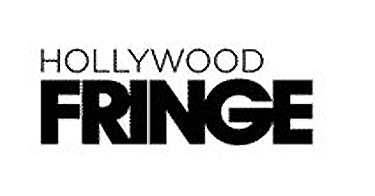 The 2012 festival had over 230 shows.
The 2012 festival had over 230 shows.
2017 had 375 shows.
The Hollywood Fringe is now the largest festival of its kind in America.
And I’m putting money on 2018, the ninth installment of the Fringe, breaking the 500-plus shows mark.
Once upon a time if you didn’t experience the Hollywood Fringe you could fall back on the excuse of ignorance (I’m sorry, did I mention the lack of civic collaboration, media support (KCRW aside) and commercial patronage?)
But ignorance is quickly becoming invalid as an excuse.
During June of 2017 I only managed to see 89 shows but here are the best:
Now perhaps it being the “Hollywood” Fringe explains the number of shows dealing with the notion of stardom, and the price paid to achieve it.
Andrew Perez’s one maniac (not a typo) show The Second Coming of Klaus Kinski treated us to adventures in the mind of the German actor best known for the films Aguirre, the Wrath of God (1972) and Fitzcarraldo (1982). Perez and director Eric Johnson captivated audiences in this staggering examination of how thin the line is between genius and madness.
Employing Samuel Beckett’s absurdist play Waiting for Godot, Writer/Director Richard Lucas’ stingingly clever and sharply funny Bono and the Edge Waiting for Godomino’s mocked the absurdity of fame and stardom by transposing Beckett’s two tramps to Bono and David Evans of the rock band U2. Performed to prickly perfection by Lucas, Curt Collier, Jeff Blumberg and Bruno Oliver.
Director/Adapter Ezra Buzzington placed the concept of fame before his audiences in Andy: The Red-nosed Warhola. A riotous cerebral rollercoaster ride that featured Kara Emry as Warhol and Krista Conti and Will McMichael as “Beauty #1” and “Beauty #2.”
From Australia came another investigation of the cost of fame in Joanne Hartstone’s one woman show The Girl Who Jumped Off the Hollywood Sign directed by Vince Fusco, an honest exploration of how far one falls when they let go of their dreams.
Its polar opposite was one of the most entertaining shows of the 2017 Fringe,
Help! I Think I Might Be Fabulous, a musical review by Brit Alfie Ordinary that charmed everyone lucky enough to see it.
Cathy Thomas-Grant’s staging, in association with Rogue Machine, of Lynda Radley’s intense and uncompromisingly bold play The Interference addressed sexual violence on today’s campuses in the language of a classical Greek tragedy as a young woman defies the fate of a victim that society seeks to force on her.
Thomas-Grant’s direction, relentless and powerful, also offered a superb ensemble effort with Chris Bozzini, William Craig, Addyson E. L. Culpepper, Dakota Dickerson, Mallory Erwin, Jacquelyn Ferguson, Alexandria Garrett, Parker Johnson, Buddy Kennedy, Brittan King, Caroline Pitts and Brandon Ruiz.
Another piece of stunning ensemble work was James Cougar Canfield’s historical piece about England’s most oft-married king and his six queens in Ladies in Waiting: The Judgment of Henry VIII. Under Director Mitchell Glass, Henry (Canfield) is challenged after his death by the women he wooed, wed, loved, discarded and condemned. His royal ladies were: Hilary Kelman (Catherine of Aragon), Wendy K. Skuse (Anne Boleyn), Laryssa Schoeck (Jane Seymour), Jennifer Haining (Anne of Cleves), Elli Stovall Brown (Catherine Howard) and Claiborne Tomlinson (Katherine Parr). By comparison, television’s The Tudors are on par with a weak episode of Kukla, Fran and Ollie (Google it.)
There was a cornucopia of talent which also reflects the sweep of subjects covered by Fringe shows: Stephen Spiegel as Lincoln’s assassin in An Evening With John Wilkes Booth, Marc Peter Reyna as one of baseball’s legendary bad boys in Mungo! and Steve Scott as the man who was once thought of as America’s worst president in Secret Honor, The Last Testament of Richard M. Nixon.
Also deserving mention is Damla Coskun as the chimp in Chimpskin, and in Solomon: King, Poet, Lover – Marcus J. Freed delivered a tour de force performance in his learned “comedy about one man and 700 wives.”
Writers and language was another repeated motif of the Fringe: the history of the ancient Korean king who transformed the way his people spoke was the subject of Chris Yejin’s The King’s Language, which featured a splendid performance by Junesoo Ham.
Writer Steve Vlasak set his comedy Nights at the Algonquin Round Table in the midst of some of modern America’s most renowned masters of the repartee with actor Nicholas Daly Clark a standout as Robert Benchley; one of America’s most unjustly forgotten wits.
In The Sacred Beasts, writer/director Chris Wollman mined a rich vein of historical gold with the “Odd Coupling” friendship between Ernest Hemmingway and Orson Welles.
And The Burglars of Hamm’s JJ Mayes, Rebecca Larsen, Albert Dayan, Tegan Ashton Cohan, Scott Golden, Matt & Carolyn Almos, Jon Beauregard and Jaime Robledo offered up a trio of side-splitting sendoffs of exasperating solo-shows (one an interpretive dance to the glory of the menstrual cycle) and armed their audience with sock balls in their aptly named show Easy Targets.
Two shows that had no fear of sock balls were Lee Wochner’s Triptych, a wonderful example of superior playwriting as was Two Motherf#ckrs on a Ledge (![]() ) by dramatist Ronn Johnston. Masterly directed by Christopher Game, performed with skill and gusto by Johnston and Veronica Wylie.
) by dramatist Ronn Johnston. Masterly directed by Christopher Game, performed with skill and gusto by Johnston and Veronica Wylie.
Christopher Marlowe’s 1593 play The Faggot King or The Troublesome Reigne and Lamentable Death of Edward the Second allowed director Christopher Johnson to show himself once more to be one of the most riotously creative talents working on the stages of L.A. Much aided by Jen Albert’s slashing combat choreography.
The musical standouts were:
Office Beat by Mindy and Gabe Copeland’s Tap Overload Company with their tale of office romance and corporate tyranny as told by their talented toe tapping crew. I hope we see them again in 2018.
Linden Waddell paid homage to the genius of Allan Sherman in Hello Again! The Songs of Allan Sherman directed by gifted Janet Miller.
Another of the festival’s standouts was Bill Berry’s solo performance in The Brick: A One Man Musical under the insightful direction of Kelly De Sarla.
And finally, there was Kinsherf’s Coat in which Producer/Artist Brian Wallace with help from Brittany Blouch and Diane Dwyer stunned audiences by showing them just how much fun they could have by staring at a coat on a chair for half-an-hour.
♦
Yes, 2017 did occasionally see on the stages of Los Angeles the equivalent of dramatic road-kill.
At the Fringe there was the insipid Zombie Clown Trump: An Apocalyptic Musical and the mind-numbingly, lame ego stroke of Chimera Bella.
Elsewhere there was Matt Chait’s intellectually flawed and ineptly crafted parade of “straw men” Disinherit the Wind, and Director/Executive Producer Gloria Gifford’s “Three-Card Monte” game played on students of her acting class under the title of Antony and Cleopatra -The Musical.
And let us not forget Matthew Lopez’s fraudulent and feeble religious/ civil war drama The Whipping Man, which has exposed that as a body dramaturges and literary managers never took courses on comparative religions and American history. ![]()
I’d like to point out that of the 3,715 words I’ve poured out in this euphoric trumpeting of my “Best of” picks for L.A.&, that it only required 117 words to brush aside the “Worst of.”
And that, more than anything else, tells you the story of L.A. theatre.
So Happy New Year wishes to all my fellow theatre junkies.
Let’s go forth in 2018 and overflow the stages of this city with brilliance, beauty, passion and wisdom.
♦ ♦ ♦
![]() And I still loathe that title.
And I still loathe that title.
![]() Yes, I saw this play in 2015, but it was bad enough to revile for at least a decade…. Or more.
Yes, I saw this play in 2015, but it was bad enough to revile for at least a decade…. Or more.
![]() Oh, and somebody told me Ingersoll Speaks! was pretty good too.
Oh, and somebody told me Ingersoll Speaks! was pretty good too.
We here at The TVolution send you thanks for supporting us all year. We are grateful and pledge to continue our unique coverage
on arts, entertainment and social issues brought to you by our intrepid journalists and essayists!
Here’s wishing you the best year 2018 has to offer!!
Remember to like us on Facebook,
Follow us on Twitter (@thetvolution)
and
Subscribe to our Newsletter:
We will never overflow your e-box!





